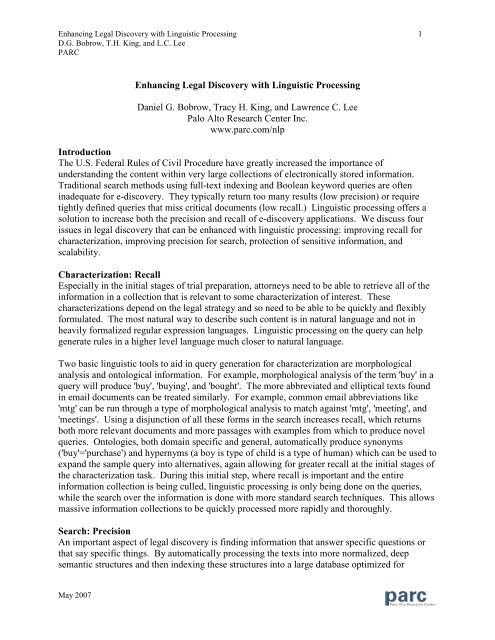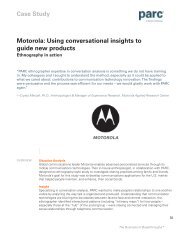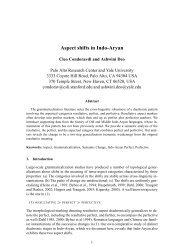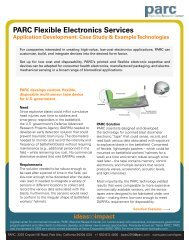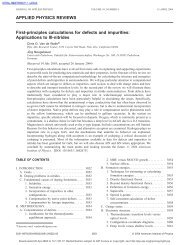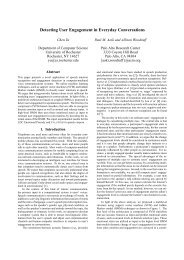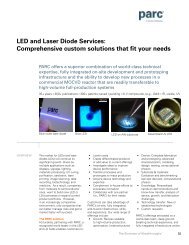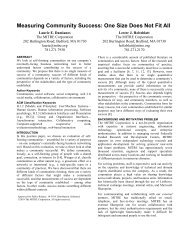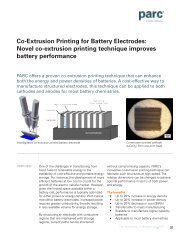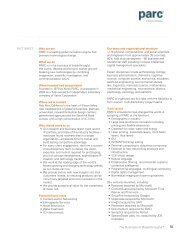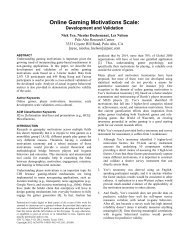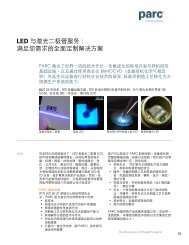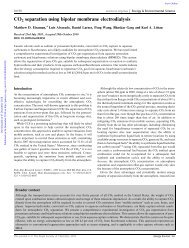PARC Linguistic Processing position paper
PARC Linguistic Processing position paper
PARC Linguistic Processing position paper
Create successful ePaper yourself
Turn your PDF publications into a flip-book with our unique Google optimized e-Paper software.
Enhancing Legal Discovery with <strong>Linguistic</strong> <strong>Processing</strong> 1<br />
D.G. Bobrow, T.H. King, and L.C. Lee<br />
<strong>PARC</strong><br />
Enhancing Legal Discovery with <strong>Linguistic</strong> <strong>Processing</strong><br />
Daniel G. Bobrow, Tracy H. King, and Lawrence C. Lee<br />
Palo Alto Research Center Inc.<br />
www.parc.com/nlp<br />
Introduction<br />
The U.S. Federal Rules of Civil Procedure have greatly increased the importance of<br />
understanding the content within very large collections of electronically stored information.<br />
Traditional search methods using full-text indexing and Boolean keyword queries are often<br />
inadequate for e-discovery. They typically return too many results (low precision) or require<br />
tightly defined queries that miss critical documents (low recall.) <strong>Linguistic</strong> processing offers a<br />
solution to increase both the precision and recall of e-discovery applications. We discuss four<br />
issues in legal discovery that can be enhanced with linguistic processing: improving recall for<br />
characterization, improving precision for search, protection of sensitive information, and<br />
scalability.<br />
Characterization: Recall<br />
Especially in the initial stages of trial preparation, attorneys need to be able to retrieve all of the<br />
information in a collection that is relevant to some characterization of interest. These<br />
characterizations depend on the legal strategy and so need to be able to be quickly and flexibly<br />
formulated. The most natural way to describe such content is in natural language and not in<br />
heavily formalized regular expression languages. <strong>Linguistic</strong> processing on the query can help<br />
generate rules in a higher level language much closer to natural language.<br />
Two basic linguistic tools to aid in query generation for characterization are morphological<br />
analysis and ontological information. For example, morphological analysis of the term 'buy' in a<br />
query will produce 'buy', 'buying', and 'bought'. The more abbreviated and elliptical texts found<br />
in email documents can be treated similarly. For example, common email abbreviations like<br />
'mtg' can be run through a type of morphological analysis to match against 'mtg', 'meeting', and<br />
'meetings'. Using a disjunction of all these forms in the search increases recall, which returns<br />
both more relevant documents and more passages with examples from which to produce novel<br />
queries. Ontologies, both domain specific and general, automatically produce synonyms<br />
('buy'='purchase') and hypernyms (a boy is type of child is a type of human) which can be used to<br />
expand the sample query into alternatives, again allowing for greater recall at the initial stages of<br />
the characterization task. During this initial step, where recall is important and the entire<br />
information collection is being culled, linguistic processing is only being done on the queries,<br />
while the search over the information is done with more standard search techniques. This allows<br />
massive information collections to be quickly processed more rapidly and thoroughly.<br />
Search: Precision<br />
An important aspect of legal discovery is finding information that answer specific questions or<br />
that say specific things. By automatically processing the texts into more normalized, deep<br />
semantic structures and then indexing these structures into a large database optimized for<br />
May 2007
Enhancing Legal Discovery with <strong>Linguistic</strong> <strong>Processing</strong> 2<br />
D.G. Bobrow, T.H. King, and L.C. Lee<br />
<strong>PARC</strong><br />
semantic search, queries over the information collection can be made in natural language. These<br />
linguistic structures normalize away from the vagaries of natural language sentences, encoding<br />
the underlying meaning. At the simplest level, surface forms of words are stemmed to their<br />
dictionary entry and synonyms and hypernyms are inserted. However, the linguistic processing<br />
can go much deeper, normalizing different syntactic constructions so that expressions which<br />
mean the same thing have the same linguistic structure. As a simple example, 'Mr. Smith bought<br />
4000 shares of common stock.' and '4000 shares of common stock were bought by Mr. Smith'<br />
will be mapped to the same structure and indexed identically. Thus the creation of this<br />
semantically based index of information stores a normalized but highly detailed version of the<br />
content in the information and includes links back to the original passages in the information.<br />
The queries against the information collection are similarly automatically processed into<br />
semantic representations at query time, and these semantic representations are used to query the<br />
database for relevant documents. Unlike more standard search techniques, using the deeper<br />
semantic structures allows for greater precision and hence fewer irrelevant documents to review.<br />
The linguistic structures encode the relations between entities and actions (e.g., who did what<br />
when) so that only documents describing entities in the desired relations are retrieved. For<br />
example, standard search techniques would retrieve both 'X hit Y' and 'Y hit X' from a search on<br />
the entities X and Y and the 'hit' relation since all of the relevant items are mentioned. However,<br />
when searching for evidence in a massive information collection, it is important to return only<br />
the text passages which refer to the intended relationship among the entities.<br />
Redaction<br />
E-discovery increases in complexity when issues of confidentiality are considered. Over the past<br />
several years we have been researching intelligent document security solutions, initially focusing<br />
on redaction. This line of research involves building better tools to detect sensitive material in<br />
documents, especially entities and sensitive relations between entities, determining whether<br />
inferences can be made even when sensitive passages have been redacted, and providing efficient<br />
encryption techniques to allow content-driven access control.<br />
The detection of sensitive material works on the same underlying technology described above for<br />
enhancing recall and precision. The use of stemming, synonyms and hypernyms, and automatic<br />
alias production increase recall, allowing for a single search to retrieve entities in many surface<br />
forms. The structural normalization provided by the deep processing similarly allows for better<br />
relation and context detection. As an additional part of the content discovery for redaction, our<br />
current research examines ways to allow for collaborative work on the same document collection<br />
so that knowledge discovery workers can benefit from each other's work and so that experts can<br />
help hone the skills of novices. Another component of the project involves using the Web and<br />
other large information collections to determine whether the identity of entities can be detected<br />
even when they have been redacted. For example, removing someone's name but leaving their<br />
birthdate, sex, and zip code may uniquely identify them, thereby suggesting that further material<br />
needs to be redacted.<br />
May 2007
Enhancing Legal Discovery with <strong>Linguistic</strong> <strong>Processing</strong> 3<br />
D.G. Bobrow, T.H. King, and L.C. Lee<br />
<strong>PARC</strong><br />
Once the sensitive text passages have been identified, we provide tools for encrypting document<br />
passages and assigning keys so that different users can have access to different types of redacted<br />
material. This makes it possible for the document to be viewed in different ways by different<br />
people: some may have access to the whole document, some may not be able to see anything<br />
related to entity X, and some may only be able to see publicly available material. This<br />
encryption capability can either be used actively on the electronic versions of the documents or<br />
can be used to prepare specially redacted versions for printing and shipping to different parties.<br />
Scalability<br />
As the average number of documents involved in each legal discovery process increases,<br />
scalability is an important issue for any technology used in the process. The linguistic<br />
processing that we advocate here is more computationally intensive than shallower methods such<br />
as keyword search or basic regular expression pattern matching over plain text. To surmount this<br />
issue, we use faster processes to go from, for example, 100 million documents to a few million<br />
documents; these faster processes may be facilitated by some linguistic processing, e.g.<br />
stemming of words so that more matches on basic keyword searches are found. Once the<br />
original information collection is reduced to a more manageable load, then the slower but more<br />
accurate linguistically-enhanced processes can be used to prune to a few hundred thousand. We<br />
have evidence that this deeper linguistic processing will scale to hundreds of thousands of<br />
documents, with processing time approaching one second per sentence. Once this initial<br />
linguistic processing is done, then the resulting indexed documents can be used repeatedly in the<br />
applications described above, thereby creating a resource to be shared across the discovery<br />
processes.<br />
Conclusion<br />
There are a number of benefits from using linguistic processing in e-discovery applications.<br />
<strong>Linguistic</strong> processing can provide fast and flexible characterization of large information<br />
collections in pre-trial preparation, as well as enable high precision search and confidential<br />
information access in discovery. While linguistic processing is more computationally intensive<br />
than keyword search, the technology does scale well to large information collections and can<br />
also be used in combination with standard search approaches to improve the management and<br />
discovery of electronically stored information.<br />
May 2007


